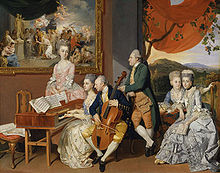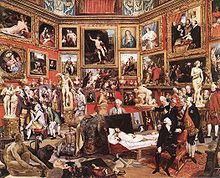- Conversation piece
-
For other uses, see Conversation Piece (disambiguation).
 A conversation piece by Arthur Devis
A conversation piece by Arthur Devis
 Johann Zoffany, The Gore Family
Johann Zoffany, The Gore Family
 Johann Zoffany paints a group of Englishmen in Rome for the Grand Tour, united only by their wealth and love of art; unlike most conversation pieces, this was not a commissioned work.
Johann Zoffany paints a group of Englishmen in Rome for the Grand Tour, united only by their wealth and love of art; unlike most conversation pieces, this was not a commissioned work.
Conversation piece is a term for an informal group portrait, especially those painted in Britain in the 18th century, beginning in the 1720s. They are distinguished by their portrayal of the group apparently engaged in genteel conversation or some activity, very often outdoors. Typically the group will be members of a family, but friends may be included, and some groups are of friends, members of a society or hunt, or some other grouping. Often the paintings are relatively small, about the same size as a half-length portrait but in horizontal or "landscape" format; others are much larger.
The genre was developed from 17th century portraiture in the Low Countries, where many group portraits were painted, both of family groups and groups such as Governors or Regents of institutions, or militia officers. Frans Hals, Rembrandt and other artists had adopted a variety of poses to liven up the group portrait, for example the famous Night Watch. The name derives from the Italian term, also used in English, sacra conversazione for a similarly informal painting of the Virgin and Child with saints, a genre developed in the Renaissance.
There are many varieties of conversation piece. People may be portrayed sharing common activities such as hunts, meals, or musical parties. Dogs and/or horses are also frequently featured. Arthur Devis was a regional painter famous for his small conversation pieces, popular with the gentry of Cheshire. William Hogarth also worked in the genre, and parodied it in his print A Midnight Modern Conversation, which depicted a group of men whose conversation has degenerated into drunken incoherence. The German artist, settled in England, Johann Zoffany, specialized in complicated conversation pieces, and most portraits by George Stubbs take this form, with horses and carriages in the composition. Joshua Reynolds would on request produce conversation pieces in the Grand Manner, and at his usual near-life scale.
The phrase "conversation piece" later acquired a different meaning.[1] It came to refer to objects that were perceived to be interesting enough to spark conversation about them. They provide a stimulus for prop-based conversation openers. The original conversation pieces sometimes depicted a group united in conversation about an object, which would typically be an item linked to science or scholarship.
References
- Mario Praz, Conversation Pieces: A Survey of the Informal Group Portrait in Europe and America (University Park and London: The Pennsylvania State University Press, 1999)
- ^ "conversation piece". American Heritage Dictionary of the English Language. http://education.yahoo.com/reference/dictionary/entry/conversation%20piece.
External links
Categories:- Portrait art
- Iconography
- English art
Wikimedia Foundation. 2010.
